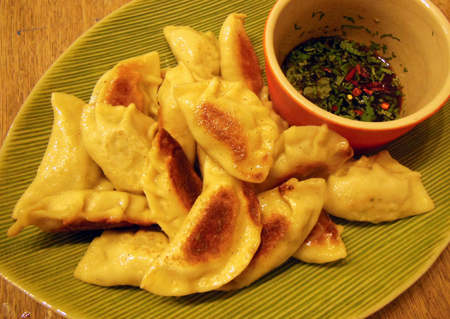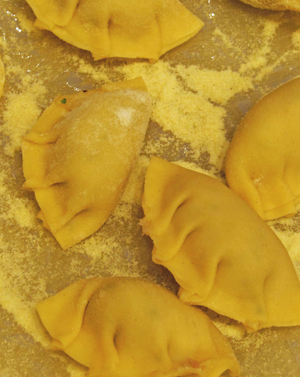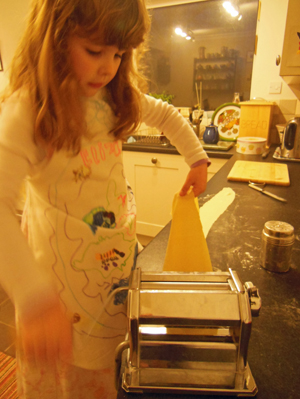I adore Japanese food and I’ve had a mini obsession with gyoza (Japanese dumplings) since I first had them in Wagamamas 15 years ago.
When I was travelling in Tokyo my love affair even led me to seek out a ‘Gyoza Stadium’ (inside Namja Town a rather bonkers video game theme park featuring a strange cartoon girl and a ghost cat!!!) which had a whole ‘street’ of booths selling hundreds of types of gyoza. I was expecting a taste sensation but the dumplings I tried there were a bit disappointing. I decided (dare I say it) that I preferred the anglicised Wagamama’s version back home.
This recipe takes the Europeanisation of gyoza one step further and uses home-made pasta sheets as the dumpling wrappers. I came across the idea in Jamie Oliver’s ‘The Return of the Naked Chef’ and I think it works really well. If you’re not into making your own pasta then you could use ready-made gyoza wrappers which you can buy from Asian supermarkets. The filling is similar to Jamie’s recipe but I form mine into half-moon shapes and cook by frying on one side and then steaming in the same pan – which I believe is more traditional.
These are a labour of love and you have to have a calm head as they are rather fiddly to assemble. In my view though, they are definitely, definitely worth it.
Gyoza
Makes about 20 (enough for 4 people as a starter)
Pasta
- 110g 00 flour, or plain flour
- 1 egg
- A dash of oil (use a tasteless oil, not olive oil)
- A pinch of salt
Filling
- 150g pork (I use the scraggy ends of a piece of pork filet)
- 1 clove garlic
- 10g ginger
- 1 teaspoon of lemon juice
- 1 handful of fresh coriander, including stalks
- 2 teaspoons sesame oil
- 8 water chestnuts (from a small tin)
- A good pinch of salt
- A little black pepper
- 1 tablespoon of groundnut oil for frying
- A ladleful of hot water
Preparing the filing
To make the filing whizz up the ginger and garlic in a food processor or mini chopper. Then add all the other filling ingredients (meat, lemon juice, coriander, sesame oil, chestnuts, salt and pepper) and blitz again until relatively smooth.
Making the wrappers
Put all of the pasta ingredients in a bowl and mix together with your hands until it comes together in a ball. Lightly flour your work surface and knead the dough for a few minutes until smooth. Wrap the dough in cling film and leave to rest in the fridge for at least half an hour.
Clamp your pasta machine to your work surface and set the machine to its thickest setting. Start by flattening the ball a little with your hands and then run through the machine. Keep rolling the piece through the machine changing for thinner and thinner settings until you reach the thinnest setting possible.
Cut out circles of pasta with a 7cm diameter cutter. Put the offcuts back through the pasta machine and cut out more circles, repeating until you have run out of dough. You should be able to get at least 20 circles from this amount of dough.
Assembling the gyoza
Put a small dollop of filling into the centre of each pasta circle. Lightly water the edge of the circle with your finger and fold the circle in half. Seal the edges and then pleat around the edge as in the photo below.
This is a little laborious so make yourself a nice pot of tea, or pour yourself a glass of wine and set about it with a calm head. If you’re in the right frame of mind then it’s actually rather enjoyable.
Put each gyoza onto a cling film covered board sprinkled with a little semolina or flour to stop them sticking.
Cooking the gyoza
Heat a tablespoon of groundnut oil in a frying pan until hot. Add the gyoza to the pan and fry until they are golden on one side. Add a ladleful of boiling water to the pan and then immediate put a lid on and steam the gyoza in the pan for 4-5 minutes until the water has evaporated and the dumplings are cooked through. Serve immediately.
Serving
I like to make a dipping sauce using 3 parts soy sauce to 1 part rice wine, garnished with some coriander and red chilli.
NOTE: You can also make this recipe using chicken or prawns instead of pork.


